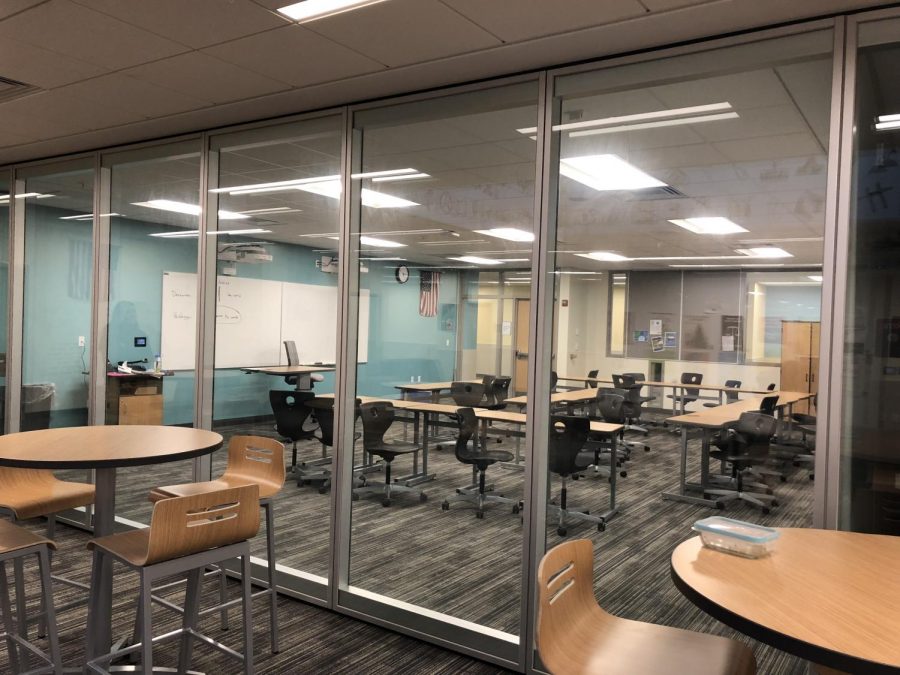Students question safety of new wing amid mass shootings
Many students question precautions and overall safety of new wing design
Following the events at Marjory Stoneman Douglas High School in Parkland, FL, students have wondered about the safety procedures at New Trier, especially in the new building.
“The new building is a new learning environment with more open spaces and windows that have many proven benefits for teaching, learning, collaboration, and social interaction,” said Athena Arvanitis, Director of Student Life.
“While these types of spaces are common features in new educational buildings, they do require a slightly different response in case of a lock down.”
While the windows of various sizes and placements in the new building have been a concern to students, Arvanitis said that they are not an Achilles heel, because windows in critical places have shatterproof film on them, as an extra layer of protection.
“Safety comes in layers,” said Arvanitis, who pointed out the hallway doors as a prime example.
“The big doors in the hallways are closed and locked in a lockdown emergency procedure. This practice came as a recommendation from law enforcement and the Winnetka Fire Department in order to limit access and isolate people from potential danger.”
Despite the safety measures put in place, students have questioned their daily safety due to the lack of knowledge they have about safety precautions in classrooms.
“The old building makes me feel safer because there are more places to hide, and it’s harder to be seen, versus my classes in the new building with lots of windows,” said sophomore Hannah Bender.
“It would be a good idea to get something to put in front of the windows, so people can’t break in, and students inside wouldn’t be harmed by glass or shrapnel,” said Bender, one of many students unaware of shatterproof film installed on some windows in the west wing.
Although the visitor check- in process has been modified, by enforcing the action of taking and holding an ID until the visitor leaves, Arvanitis explained that safety is a school wide effort, which requires students to be aware of their behavior too.
This includes increased awareness of the many doors we enter in the morning, and at other times of the day.
“It’s kind of weird how easily students can come and go, which makes it seem like people that don’t belong can come in easily, too,” said Junior Elena Hollis.
“It’s nice to be able to come in almost any door without a problem, but it can also not be safe,” added Hollis. “I’m not quite sure what the middle ground is though.”
While it may seem easy to enter and exit the building, school visitors will continue to be, as they always have been, checked in as they enter the school, by showing a form of identification and given a visitors’ badge, which follows standard procedure for many schools.
In an email from superintendent Paul Sally to parents, he assured community members that the school is in constant communication with the Winnetka Police Department, and constantly monitors school entrances.
“We are increasing our monitoring and communication with students to make sure they do not open unauthorized doors for anyone, and do not prop open doors,” wrote Sally.
Not only have the events in Parkland, FL sparked greater conversation about school safety, they have also sped up emergency decision making, and inspired further staff training that is more tailored to lock downs.
“Going forward, I’d like to see more lock down, lock out, and lock in drills to make us feel more prepared,” said Junior Will Bechtel.
Some students aren’t aware of the differences between lock ins, locks outs, and lockdowns, mentioned Bechtel.
If there is a suspected person of danger in the school, the school will go into a lock down, and everyone will immediately go into a safe space, such as a classroom, office, or closet, and lock doors until further notice.
If there is a potentially dangerous person or event happening in the area, but off campus, the school will go into a lock out, where students will not be allowed to leave the school and no one will be allowed to enter the building, until the threat is resolved.
Lock-ins, to be renamed as ‘hold in place,’ occur when there is a medical emergency, or a non-life threatening event, inside the building, where students will not be allowed to leave their classroom in order to easily solve the problem without added commotion.
“We take school safety very seriously,” said Arvanitis. “The new building, like the existing campus buildings, has many safety features incorporated, and we train with students and staff about what to do in different types of emergencies. As we get feedback on that training, we have been tweaking our procedure to fit the new building.”
In his email, Sally wrote “We want all students to feel safe every day at New Trier. While best practices in security planning mean that we cannot share detailed information about our security measures publicly, please know that we work every day, in all parts of the school, to provide as safe and secure a school environment as we can.”






































